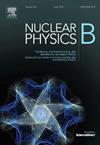The multiplicity distributions of the high frequency gravitons
IF 2.8
3区 物理与天体物理
Q2 PHYSICS, PARTICLES & FIELDS
引用次数: 0
Abstract
When the gravitons are created thanks to the variation of the space-time curvature the multiplicity distributions quantify the probability of producing a given number of species around the average occupation numbers of the underlying multiparticle states. The multiplicities of the relic gravitons are infinitely divisible and their analytical expressions encompass, in different regions of the physical parameters, the Poisson, Bose-Einstein, Gamma and Pascal probability distributions. Depending upon the post-inflationary timelines, the averaged multiplicities are controlled by the range of the comoving frequencies and they can be much larger in the GHz region than in the aHz domain where the temperature and polarization anisotropies of the microwave background set strict limits on the spectral energy density of the relic gravitons. Thanks to the absolute upper bound on the maximal frequency of the gravitons we can acknowledge that the averaged multiplicities are exponentially suppressed above the THz, where only few pairs of gravitons are independently created from the vacuum. The statistical properties of the produced particles can be finally interpreted in the light of the second-order interference effects and this perspective is quantitatively scrutinized by analyzing the associated quantum sensitivities. For putative instruments reaching spectral amplitudes in the MHz or GHz bands, the Bose-Einstein correlations could be used to probe the properties of cosmic gravitons and their super-Poissonian statistics. Both from the theoretical and observational viewpoint it is unjustified to require the same sensitivities (e.g. ) in the kHz and GHz domains.
高频重子的多重性分布
当引力子由于时空曲率的变化而产生时,多重性分布量化了在基础多粒子态的平均占据数周围产生给定数量的物种的概率。遗迹引力子的多样性是无限可分的,它们的解析表达式在物理参数的不同区域包含泊松、玻色-爱因斯坦、伽玛和帕斯卡概率分布。根据暴胀后的时间线,平均多重度由共动频率的范围控制,在GHz区域比在aHz区域要大得多,在aHz区域,微波背景的温度和极化各向异性严格限制了遗迹引力子的光谱能量密度。由于引力子最大频率的绝对上限,我们可以承认平均多重度在太赫兹以上被指数抑制,在那里只有少数引力子对是独立于真空产生的。产生的粒子的统计特性最终可以根据二阶干涉效应来解释,并通过分析相关的量子灵敏度来定量地审查这一观点。对于在MHz或GHz波段达到谱幅0(10−35)/Hz的假定仪器,玻色-爱因斯坦相关性可用于探测宇宙引力子的性质及其超泊松统计。从理论和观测的角度来看,在kHz和GHz域中要求相同的灵敏度(例如O(10−21)/Hz)是不合理的。
本文章由计算机程序翻译,如有差异,请以英文原文为准。
求助全文
约1分钟内获得全文
求助全文
来源期刊

Nuclear Physics B
物理-物理:粒子与场物理
CiteScore
5.50
自引率
7.10%
发文量
302
审稿时长
1 months
期刊介绍:
Nuclear Physics B focuses on the domain of high energy physics, quantum field theory, statistical systems, and mathematical physics, and includes four main sections: high energy physics - phenomenology, high energy physics - theory, high energy physics - experiment, and quantum field theory, statistical systems, and mathematical physics. The emphasis is on original research papers (Frontiers Articles or Full Length Articles), but Review Articles are also welcome.
 求助内容:
求助内容: 应助结果提醒方式:
应助结果提醒方式:


